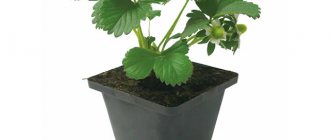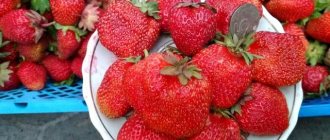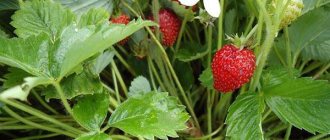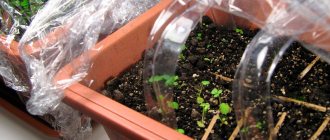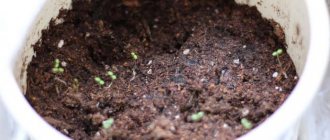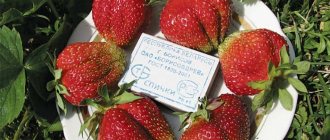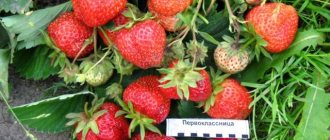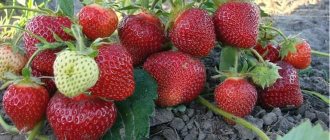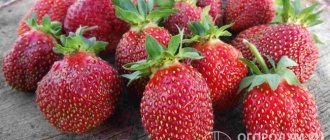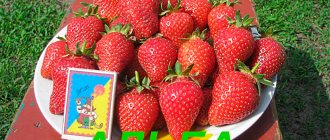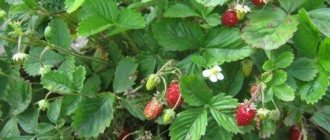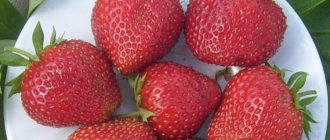History of selection and regions of cultivation of Diamant strawberries
This variety was bred in 1997 by breeders in California. Until today, it is one of the most popular and widespread among gardeners. Strawberries can withstand low temperatures and do not tolerate dry climates.
It is better to plant this crop in regions with temperate climatic conditions, where the temperature does not drop by more than -20 °C. The most suitable conditions for this variety will be a flat area, protected from strong gusts of wind and drafts with sufficient sunlight and occasional shade.
Pros and cons of remontant variety
This variety of strawberry has characteristic advantages:
- repairability;
- large fruits;
- average resistance to frost and dry climates;
- unpretentiousness in care;
- taste qualities of the berry;
- possibility of long-term transportation and storage of fruits.
Among the disadvantages it should be noted:
- poor tolerance to increased soil moisture;
- crushing berries with dense crop growth.
Description of Delhi strawberries
An early variety of strawberries, Deli, was developed in Italy quite recently. Gardeners fell in love with strawberries due to their winter hardiness and excellent taste. It can be easily grown in continental climates.
Delhi strawberry bushes are of medium density. They are quite large and covered with beautiful dark green leaves. The flower stalks are quite powerful and strong. They are located at the level of the leaves or slightly lower. The growth rate of Delhi strawberry bushes is high. Enough antennae appear on them for further reproduction. There are few of them and this greatly simplifies the care of crops for gardeners. Flowers are medium in size. They contain a large amount of pollen, which is the result of the ripening of beautiful fruits.
Delhi strawberries are quite large. The average weight of one fruit reaches from 30 to 45 g. The berries retain their weight and shape during the entire fruiting period. The shape of Delhi strawberries resembles a heart. They are very beautiful, presented in bright red color. The red flesh is quite dense and fleshy, does not contain coarse fibers. The fruits have a pleasant dessert taste and a wonderful strawberry aroma.
Advantages
Delhi variety strawberries have many advantages, including:
- Quite large berries.
- Early ripening.
- It bears fruit for quite a long time.
- The harvest is stable.
- Handles transportation well.
- It has an amazing dessert taste and amazing strawberry aroma.
- High level of frost resistance.
- Practically not susceptible to powdery mildew, brown spot and anthracnose.
- The fruits are universal in use.
- Easily propagates without any problems.
- Can be grown both in greenhouses and in open ground.
Negative qualities
Any culture has not only advantages, but also certain disadvantages. Delhi strawberries are no exception. Disadvantages of culture include:
Excessive demands on the soil in which it grows. When the soil is heavily moistened, the fruits lose their sweetness and become more watery. It is necessary to pay special attention to the alignment.
Of course, such shortcomings can easily be forgiven for Delhi strawberries, because they have much more positive qualities.
Productivity
Gardeners begin harvesting the first harvest of Delhi strawberries from the beginning of June. From one strawberry bush you can collect about 800 g of fresh, juicy, tasty, aromatic berries. Strawberries, laid out in 1-2 layers in boxes, can be transported over long distances. They tolerate transportation well without losing their attractive appearance and taste.
Delhi strawberries can easily be used to make compotes and jam. If you follow the cooking technology correctly, the fruits will remain intact.
Features and characteristics of berry crops
The main feature of the Diamant strawberry variety is the remontant nature of the plant, due to which the crop can bear fruit throughout the year, but only if the necessary maintenance environment and proper care are observed.
Despite the fact that the variety is remontant, with constant fruiting the berries do not begin to become smaller, but remain consistently medium in size. In addition, one can note the high productivity of the plant. Under good conditions, one bush can bear up to 2 kilograms of fruit.
The crop is grown not only in personal garden beds, but also in the production of various products.
Bush size
The Diamant strawberry bush grows easily and can reach a length of 30-50 centimeters. For this reason, the plant is often used as a decorative decoration, hanging it in a flower pot.
Appearance of the sheet plate
Diamond leaves are large in size, have a dark green matte color and small wrinkles on the surface. The edges of the leaves have characteristic teeth.
Flowering and pollination
With the right level of warmth, the variety can begin flowering in early spring and last throughout the year if the conditions meet the needs of the plant. Since the variety has bisexual flowers, it can pollinate on its own without the need for other crops in the garden.
Ripening time and yield
Full ripening of the fruit occurs approximately 3-4 weeks from the moment the fruit is formed. The yield of the Diamant variety is high and, subject to the conditions necessary for the plant, can reach 2 kilograms per bush per season. Since the plant is remontant, such a harvest can last for several months in a row, until the onset of frost. The average berry size is approximately 30 grams, but can reach 40-50 grams.
See also
How often can you water strawberries, rules and timing of the procedure
Read
Taste qualities of the fruit and its further sale
Tasters rate the taste qualities of Diamant strawberries at 4.7 points out of 5 possible. The berries have a sweet taste with a slight sourness, which manifests itself in the aftertaste. The fruit has a persistent strawberry aroma and a dense pulp structure. One of the disadvantages is the insufficient juiciness of the berries. Subsequently, the fruits are used in the preparation of confectionery and other dishes, baked goods, liqueurs, natural juices, and eaten raw.
Due to the fact that the berry pulp is dense, the fruit is easy to transport over long distances, in which it does not wrinkle or get damaged. For the same reason, berries are stored for a long time.
Resistance to frost and dry weather
This variety has average resistance to frost and can withstand temperatures of at least -20 °C without special shelter. However, when frost sets in, it is recommended to mulch or cover the plants so that they are not exposed to cold temperatures and do not start to get sick. Diamant strawberry does not tolerate drought and in excessive heat or dry climate it begins to get sick, dry out and may die. The optimal temperature regime for this variety is within 20 °C, provided that the plant is systematically moistened.
Susceptibility to diseases and parasites
Strawberry Diamond has increased resistance to most diseases and parasites, so the plant should be treated only against certain pests:
- strawberry mite;
- nematode;
- leaf beetle
The culture is immune to common diseases:
- powdery mildew;
- root rot;
- verticillium.
Damage to these diseases can only be observed if infected from another plant in the neighborhood.
Main characteristics of the variety
Review of the Diamant strawberry, description of the variety, photos, reviews from gardeners, let's start with the characteristics of the crop. Remontant strawberries belong to the group of large-fruited crops. The berries grow in an elongated cone shape. The skin is shiny, bright red. At technical maturity it has an orange tint. The weight of the berry is about 32 g, but it all depends on the growing conditions. The ripe Diamond fruit is dense. The light red pulp accumulates a large amount of sugar, but is not rich in juice. Thanks to such indicators, crops can be transported over long distances.
Important! Diamant strawberries are used very rarely for processing due to their low juiciness and light pulp.
The Diamant strawberry variety has three main advantages:
- high productivity;
- presentation of berries;
- good taste.
Continuing to consider Diamant garden strawberries, description of the variety, photos, reviews, it is worth paying attention to the plant itself. Strawberry bushes grow spreading, tall with large leaves. The inflorescences are firmly held on the peduncle and protrude above the level of the foliage. With the onset of active fruit set, the formation of whiskers occurs. Diamond strawberries are grown in open and closed ground. Strawberries can bear fruit well in flower pots suspended using flowerpots.
Important! The Diamant variety is rarely affected by leaf spot, mildew, and also resists spider mites.
Landing specifics
In order for the plant to bear as much fruit as possible and not be affected by various diseases and pests, healthy seedlings should be planted, following all the rules for caring for the crop.
Site selection and preparation
It is better to plant this variety of strawberries in light soil with an acidity level not exceeding 6.5. The best place for this crop is level soil with enough sunlight. There should be a little of it so that the plant does not burn. Therefore, you need to choose an area where there is partial shade, which can briefly cover the strawberry bush every day.
Before planting seedlings in open ground, you should dig up the ground. This must be done 15-20 days before disembarkation. In addition, the area should be fed. To do this, you can use organic fertilizer or special minerals, which are sold at any garden store. After this, you need to make holes about 20-30 centimeters deep. It is recommended to place them in even rows at a distance of 60-70 centimeters. There should be 20-30 centimeters of free space between plants.
Selection of seedlings
When choosing seedlings, you should carefully check the plants for the presence of:
- spots of different colors on the leaves and stem of the crop;
- darkening;
- wilting of leaves;
- visual damage.
If damage is found on the seedlings, they cannot be purchased, since such a plant may die or become diseased.
Also, when choosing seedlings, you should pay attention to the condition of the soil in which it is located. If the soil is dry or swampy, it is better to purchase a sprout from another seller.
Timing and technology of planting seedlings
Planting of seedlings can be done in spring or autumn. If the event is held in the fall, the seedlings should be insulated before frost sets in so that they do not die. Strawberries that were planted in the spring may not begin to bloom until summer.
Before planting, the roots of the seedlings can be soaked in a special mineral solution for several hours, after which the seedlings should be placed in the hole.
When straightening the root system, you need to sprinkle everything with earth, and then compact it thoroughly. After planting, water the plant thoroughly with lukewarm water.
See also
Technology of growing strawberries in a greenhouse, details of planting and care
Read
Growing and care
The Diamant variety is demanding on soil fertility and quality of irrigation.
Watering
Watering strawberries is especially important during the flowering period and the beginning of berry ripening. The frequency of watering is once every 5 days.
Drip irrigation is preferred. In case of heavy precipitation, strawberries do not need additional watering. Diamond does not tolerate heat and drought well, so in the southern regions it requires shading.
Loosening, weed control
There should be no weeds on the beds. The absence of weeds is a guarantee of productivity and absence of diseases. Mulching has a good effect. Sawdust, peat, pine needles or straw will prevent moisture evaporation during dry summers and eliminate the need for weeding.
Removing a mustache
During the period of active fruiting, the plant produces a large number of whiskers. If you do not plan to propagate the variety, they must be pruned regularly.
Top dressing
The Diamant variety responds well to foliar feeding on the leaves. The best organic fertilizers are cow and horse manure, bird droppings, and nettle infusion.
Fresh bird droppings must be diluted in water 1:10 and left for 7-10 days to ferment. Before applying to the beds, the solution is diluted again 1:15. Such powerful feeding requires no more than 1 liter. on the bush.
Pest and disease control
The Diamant variety has increased immunity to powdery mildew, leaf spot, verticillium wilt and root rot. But this does not mean that strawberries do not require disease prevention.
Before the flowering phase begins, the bushes should be treated with copper oxychloride. The drugs “Intavir”, “Switch”, “Tiovit-Jet” have a good effect. Against slugs, use “Slimax” at a rate of 5-7 kg/ha, “Metaldehyde”, which will require 8-10 kg. for 1 hectare.
Preparing for winter
Strawberries can successfully overwinter only under snow cover, but it is better to use non-woven materials. It is advantageous to choose places for planting where cold air will not stagnate and snow will not be blown out.
In autumn, after the last harvest, dry foliage is cut off. Sick bushes are discarded. Exposed roots must be covered with soil. A layer of straw is poured on top. Spruce branches protect well from frost.
What kind of care does the “precious” Diamond variety require?
Strawberries of the Diamant variety are not very demanding and easily adapt to most conditions.
Watering
Watering this variety should be systematic. You should carefully monitor the condition of the soil and its moisture. If it is dry, it is necessary to urgently water it. It is important not to let the soil become swampy.
This condition of the soil can lead to a deterioration in fruiting. Diamond is immune to damage to the root system, so rotting does not occur. If it rains during the day, you don't have to water the plant.
It is better to moisten the crop with rain, so that not only the soil, but also the bush gets wet. This can only be done until the flowers appear, otherwise you may damage them.
Fertilizer
Fertilizing strawberries of the Diamant variety should be carried out 4 times a year:
- before flowering;
- during the formation of antennae;
- when fruits appear;
- while preparing the crop for frost.
Weeding and loosening the soil
Weeding should be carried out if weeds or other plants have appeared near the crop that may interfere with the normal growth of the strawberry bush. Loosening is necessary so that the watering liquid quickly reaches the root system of the crop and also saturates the soil with oxygen. This procedure is carried out after watering, when the soil is wet.
Mulching
Mulching should be done before the onset of cold weather. Usually this is winter or autumn. For the procedure you can use:
- dry grass;
- wood sawdust;
- special inorganic materials.
Shelter for the winter
Shelter for the winter should be done if the frosts are severe and exceed -20 °C. Care must be taken to ensure that the crop does not freeze. To cover plants you can use:
- plastic film;
- insulation;
- other inorganic materials.
Preventive treatments against diseases and pests
When planting, you can plant onions or garlic next to the crop so that the strawberries are not affected by pests:
- nematode;
- strawberry mite;
- leaf beetle
Among diseases, gray rot often affects the crop. To prevent it from occurring, you should carefully monitor the plant and promptly remove various organic debris around the bush so that they do not have time to rot.
You can also use a fungicide to prevent the occurrence of the disease - it perfectly prevents the spread of gray rot.
Reviews
Konstantin Krivonosov, Samara region.
I’ve been growing diamonds for about 6 years, and I’ve already renewed the plantation with mustaches. I like it for its taste and yield. Since other remontant strawberries grow, there are no difficulties in caring for them: everything is clear and familiar. On young bushes I remove the mustache completely to increase the yield. I feed and water according to schedule. I don’t count on winter hardiness - I wrap it securely. I didn’t lose a single bush after the frost.
Anastasia Abramchuk, Chelyabinsk region.
Three years ago I bought Diamond seeds, and I plan to propagate strawberries next summer. I liked the variety for its taste and beauty of the berries. I feed it organically and don’t use chemicals. The beds are covered with straw, and for the winter I put thick spruce paws and cut raspberry twigs between the bushes (they hold back the snow).
How to propagate berry bushes
Strawberry bushes can be propagated using several methods:
- division of culture;
- seeds;
- mustache
Seeds
To plant seeds, you need to keep several berries for 2-3 weeks until they separate from the fruit pulp by rotting the berries. These seeds should then be cleared of any residue. So they are ready to disembark. It is better to plant them in the fall, and move them to open ground in early spring, having previously prepared them.
Dividing the bush
Diamant strawberries are rarely grown by dividing the bush, since the procedure requires experience in carrying out such procedures. Another disadvantage of this method is the complete transfer of diseases that the original plant had to the split off sprouts.
Rosettes
Another popular method due to its simplicity and effectiveness is propagation by mustaches or rosettes. The procedure is carried out in the spring, when the antennae appear. They are distributed into prepared containers with soil and wait until the root system begins to develop, after which they are split off from the original plant.
Planting in open ground
The soil for strawberry plantings should be light and breathable with an acidity of 5.0-6.5. The depth of groundwater is at least 70-80 cm. The selected area must be level, so that there is no stagnation of water, well lit by the sun and without through winds.
Important! Strawberry bushes should be planted after legumes, grains and greens.
It is better to plant bushes at the end of May or in September. In the case of spring planting, the current year's harvest will be quite meager, but next season the strawberries will more than reward you. With autumn plantings, abundant fruiting will occur next spring.
It is better to prepare the soil for planting in advance. First, dig with a shovel, removing all the weeds along the way. Then add rotted cow manure fertilizer at the rate of 10 liters per 1 square meter. Heavy soils require the addition of sand. The prepared site for disease prevention is treated with fungicides and aged for 3 weeks.
Then, holes 15 cm deep are prepared on the site, in which the strawberries will be planted; the distance between seedlings is 30-50 cm. The plantings must be mulched to prevent rapid evaporation of moisture and the growth of weeds.
Seedlings need daily watering until complete rooting, then watering becomes less frequent every other day, then once every two days and once a week. Remontant varieties require more frequent and abundant watering for normal fruiting. You need to water with warm water at the root, saturating the soil around the bushes by at least 2-3 centimeters.
Step-by-step process of planting seedlings:
- The seedling is carefully placed in the prepared hole, the roots are straightened and covered with soil, the root collar should remain at ground level.
- Pour warm water under the roots, cover the resulting depressions with earth and lightly compact them so that there are no voids at the roots.
- Mulch with sawdust, straw or black non-woven material.
- During the hot season, plantings should be shaded from the scorching sun.
Regular watering followed by loosening the soil guarantees rapid growth of green mass and good yield.
